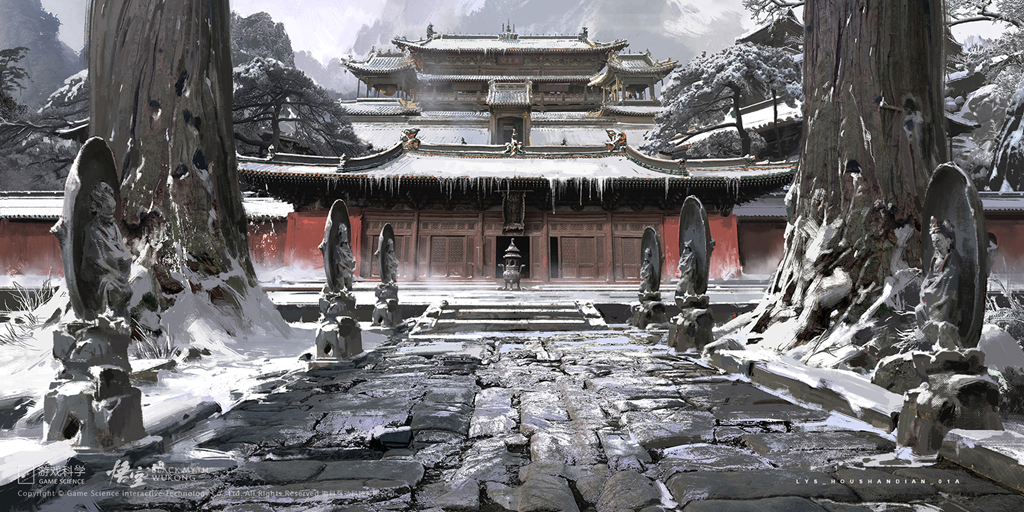Exploring China with Wukong
China’s first true AAA title, “Black Myth: Wukong,” sparked a global craze in 2024. This action role-playing game, which features high development costs, extended production cycles, and substantial resource investment, is inspired by the classic Chinese myth “Journey to the West.” It has captivated players with its stunning visuals, engaging storyline, and impressive gameplay mechanics.

The game world showcases scenes inspired by authentic ancient Chinese architecture, featuring intricately recreated temples, pagodas, archways, stone-carved caves, and sculptures that leave a lasting impression on players. This has sparked a trend among fans to explore real-life ancient Chinese buildings, extending their enthusiasm for discovery from the virtual realm into reality. Accompanying players on their journeys are the game’s distinctive soundscapes, which incorporate the powerful rhythms of Peking opera, the rugged storytelling art from northern Shaanxi, and adapted themes from the classic TV series “Journey to the West.” These timeless melodies create a rich tapestry of Chinese folk music, guiding every player who enters this enchanting land into an immersive exploration of history, art, and dreams.
In this issue, we invite you to join us in exploring “Wukong” as we delve into the realm of ancient Chinese architecture and folk music, experiencing the rich tapestry of traditional Chinese culture.
Behold the beauty of ancient Chinese architecture
Chinese architects breathe life into clay and transform stones into masterpieces. In the realm of gaming, the artistic allure of ancient Chinese architecture is vividly displayed through its various forms—graceful pavilions, towering terraces, and intricately designed towers. These classic architectural scenes not only enhance the visual richness of the gaming world but also enable players to experience the unique charm and wisdom embedded in ancient Chinese structures during their adventures. Join us as we explore the world of ancient Chinese architecture, appreciating the exceptional craftsmanship of ancient artisans and the profound understanding of harmony among heaven, earth, and humanity that these structures convey.
Pavilions: A spot to revel in open views
Pavilions are among the most open types of traditional Chinese structures, supported by just a few pillars and featuring rooftops that can take various forms, such as hexagonal, octagonal, or circular. These designs offer expansive views of the natural surroundings. Originally, pavilions were not intended for leisure; they were small fortifications established at border outposts. Over time, their role evolved, becoming integral to China’s gardens, providing resting places for visitors.
Terraces: Stunning vistas in every direction
Terraces are elevated, open, and relatively flat structures typically constructed in outdoor settings, often located on high ground or near bodies of water. Early terraces were lofty earthen platforms primarily used for viewing and ritual purposes, while also serving recreational and observational roles. Many ancient palaces in China were built atop terraces, symbolizing imperial power and authority.
Open halls: Complementing the scenic landscape
Open halls are notable for their airy design, featuring no walls and only wooden railings for safety. This layout provides a sense of openness while ensuring that visitors can enjoy the view securely. In ancient times, these structures were built on elevated earth mounds, allowing people to take in panoramic vistas from above. As the focus of classical Chinese gardens shifted from mountain vistas to riverside enjoyment, by the Han Dynasty, open halls transitioned from relying on earth mounds to becoming elegant structures situated alongside water. They transformed into ideal retreats for literati to relax, admire the scenery, and compose poetry while engaging with the surrounding water and fish.
Boathouses: Bridging land and water
With a name that suggests a boat, this structure mimics the shape of a vessel yet is firmly rooted on land. Such buildings not only bring an element of charm but also help create a harmonious layout between land and water spaces.
Studios: Finding elegance in solitude
Studios are often associated with study rooms. Since ancient times, simplicity and elegance have been essential qualities, ideally situated close to nature and away from the hustle and bustle. They provide a tranquil sanctuary for scholars to cultivate their minds and reflect. The central area, often referred to as the “reading zone,” is typically positioned between two pillars at the heart of the studio. At the back, a concealed space features a screen partition, behind which are beds and a chess set, allowing for relaxation or a game after a tiring study session. Natural light is best captured by the windows set against the walls, where a tea table and two comfortable chairs are arranged for welcoming guests.
The studio serves not only as a serene reading space but also as a gathering point for scholars to curate ancient artifacts and books, transforming it into a miniature “museum” and a “mental compass.”
“Lou” and “ge” towers: Elevating wisdom
The terms “lou” and “ge” towers denote different styles of tall, multi-story structures found in ancient China, each exhibiting unique architectural features.
A “lou” tower is defined as a multi-story structure. Originally, these were built at heights for defense and surveillance purposes. From the Eastern Han Dynasty onwards, Taoist culture began to flourish, shaping the understanding of “heaven” as a dwelling place for immortals. Thus, ascending tall towers became a symbolic act and a spiritual aspiration.
A “ge” tower is a type of storage space distinguished by its open lower level. Originating from stilt houses, these structures feature columns that lift the floor above the ground, fostering an airy and open atmosphere that encourages ventilation and prevents moisture buildup.
There is another type of building, distinct from “lou” and “ge” towers, yet incorporating building techniques and architectural features from both—this is the pagoda, which is related to the introduction of Buddhism into China. The Yingxian Wooden Pagoda in Shuozhou City, Shanxi Province, is the only remaining wooden tower-style pagoda in China.
Rear and front halls: Majestic and solemn
In traditional Chinese architecture, halls are the central structures that symbolize status and grandeur. The term “rear hall” (dian) was originally the elevated section of a building, indicating its substantial form and significant status. Over time, it became associated with royal residences, ceremonial sites, and religious structures. The character for “front hall” (tang) appeared relatively early, originally meaning the part of a building that opens outward in contrast to the inner chamber. Its purpose is for ancestral worship and to commemorate virtuous predecessors and heroes.
Both the rear and front halls are typically situated at the center or along the main axis of architectural complexes, including palaces, temples, and royal gardens. The decoration of the emperor’s halls is particularly opulent, featuring top-tier components crafted from the finest materials and of the highest value. The use of vibrant colors and intricate patterns further emphasizes the emperor’s grandeur.
Altars: Connecting humanity and the divine
Altars serve as sacred spaces for ancient rituals, creating a connection between people and deities through offerings and prayers. The ritual system has its roots in the natural worship and primitive agriculture of early societies. Our ancestors integrated their understandings of the gods of heaven and earth, the sun and moon, the state, and ancestral farmers into these practices, refining them into distinct concepts such as directions, yin and yang, and layouts. Initially held in open natural settings, these rituals eventually evolved into the construction of earthen platforms, which later developed into intricately designed stone and brick structures.
Residences: A reflection of culture and tradition
“Residences” refer to the living spaces of individuals and families, with architectural styles varying widely based on climate, environment, and cultural influences. In China, many seemingly modest homes reveal a unique blend of survival wisdom and familial traditions.

Read more:
Guide to “Black Myth: Wukong” filming locations
In the game world, there are as many as 37 scenes based on ancient Chinese buildings. The exquisite pictures not only provide players with a visual shock but also spark waves of visits to the ancient buildings. Numerous players and tourists are attracted to the locations where the scenes were filmed, so that they can fully appreciate the unique charm of ancient Chinese architecture.
Xiaoxitian
Situated in Xixian County, Linfen City, Shanxi Province, Xiaoxitian was originally constructed in the second year of the Chongzhen reign during the Ming Dynasty (1629). The Mahavira Hall features more than a thousand colorful sculptures and is renowned as the “pinnacle of suspended sculpture.” This site serves as the backdrop for the game’s iconic scene, “Kneel before the Buddha of the Future!”
Hanging Temple
Situated in Hunyuan County, Datong City, Shanxi Province, it was established during the Northern Wei period (386-534 AD). This unique temple integrates Buddhism, Taoism, and Confucianism.
Dazu Rock Carvings
Situated in the Dazu District of Chongqing, this term encompasses all stone carvings found in the region. Established during the early Tang period, these carvings represent a significant treasure of ancient Chinese stone carving art and were designated as a UNESCO World Heritage Site on December 1, 1999.
Three Pagodas of Chongsheng Temple
Located in the Dali Bai Autonomous Prefecture of Yunnan Province, the Three Pagodas include the main structure known as the Qianxun Pagoda, which is one of the tallest ancient pagodas in China. Listed as a key national cultural relic protection unit by the State Council of China in 1961, these pagodas collectively symbolize the ancient history and culture of Yunnan.
Kaiyuan Temple
Situated in Quanzhou City, Fujian Province, Kaiyuan Temple was constructed in the second year of the Chuigong reign of the Tang Dynasty (686 AD). It is the largest and most prominent Buddhist temple in Quanzhou.
Yingxian Wooden Pagoda
Nestled within Fogong Temple in Yingxian County, Shuozhou City, Shanxi Province, the Yingxian Wooden Pagoda is the tallest and oldest pure wooden structure in the world. It is acclaimed as one of the “Three Great Towers of the World,” alongside the Leaning Tower of Pisa in Italy and the Eiffel Tower in France.
Text by our staff correspondents
Translated by YNTA